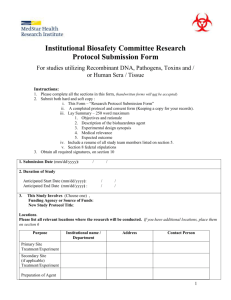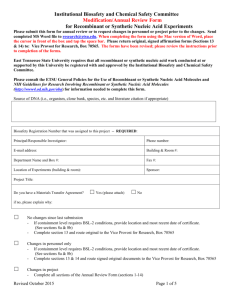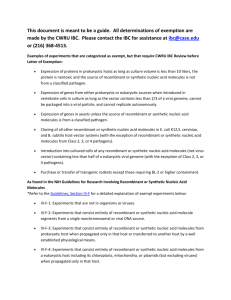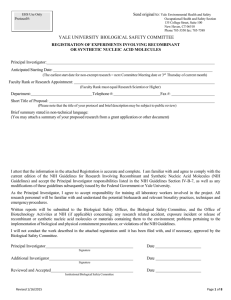Research Projects Involving Recombinant DNA
advertisement
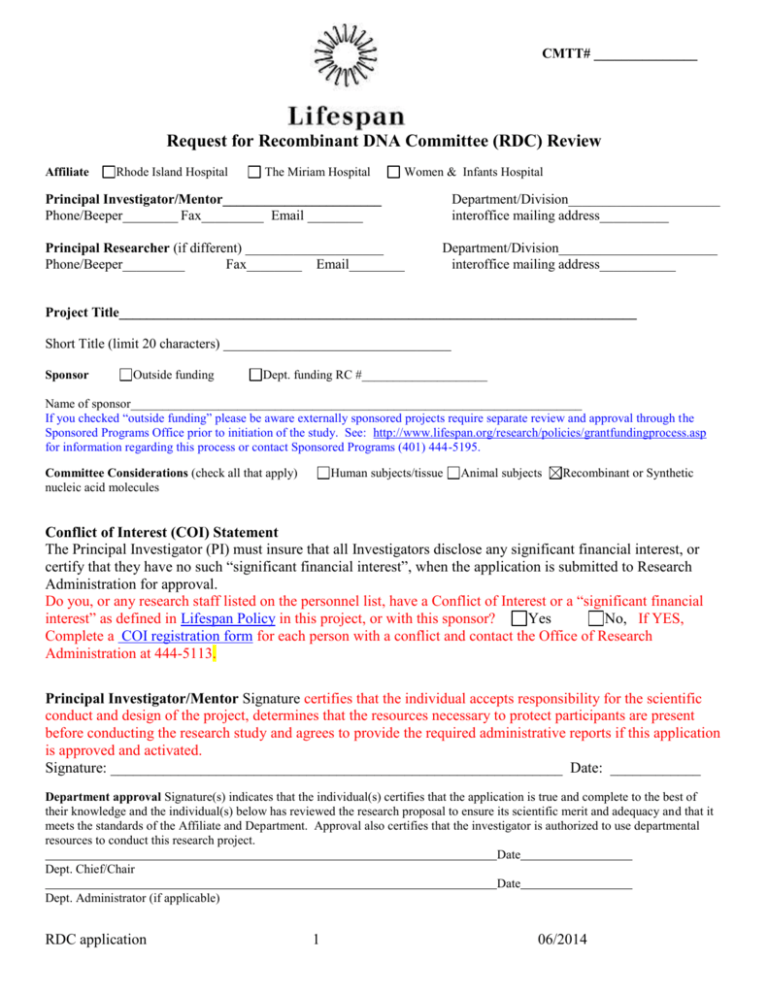
CMTT# _______________ Request for Recombinant DNA Committee (RDC) Review Affiliate Rhode Island Hospital The Miriam Hospital Women & Infants Hospital Principal Investigator/Mentor_______________________ Phone/Beeper________ Fax_________ Email ________ Principal Researcher (if different) ____________________ Phone/Beeper_________ Fax________ Email________ Department/Division______________________ interoffice mailing address__________ Department/Division_______________________ interoffice mailing address___________ Project Title___________________________________________________________________________ Short Title (limit 20 characters) _________________________________ Sponsor Outside funding Dept. funding RC #____________________ Name of sponsor________________________________________________________________________ If you checked “outside funding” please be aware externally sponsored projects require separate review and approval through the Sponsored Programs Office prior to initiation of the study. See: http://www.lifespan.org/research/policies/grantfundingprocess.asp for information regarding this process or contact Sponsored Programs (401) 444-5195. Committee Considerations (check all that apply) nucleic acid molecules Human subjects/tissue Animal subjects Recombinant or Synthetic Conflict of Interest (COI) Statement The Principal Investigator (PI) must insure that all Investigators disclose any significant financial interest, or certify that they have no such “significant financial interest”, when the application is submitted to Research Administration for approval. Do you, or any research staff listed on the personnel list, have a Conflict of Interest or a “significant financial interest” as defined in Lifespan Policy in this project, or with this sponsor? Yes No, If YES, Complete a COI registration form for each person with a conflict and contact the Office of Research Administration at 444-5113. Principal Investigator/Mentor Signature certifies that the individual accepts responsibility for the scientific conduct and design of the project, determines that the resources necessary to protect participants are present before conducting the research study and agrees to provide the required administrative reports if this application is approved and activated. Signature: ____________________________________________________________ Date: ____________ Department approval Signature(s) indicates that the individual(s) certifies that the application is true and complete to the best of their knowledge and the individual(s) below has reviewed the research proposal to ensure its scientific merit and adequacy and that it meets the standards of the Affiliate and Department. Approval also certifies that the investigator is authorized to use departmental resources to conduct this research project. Date Dept. Chief/Chair Date Dept. Administrator (if applicable) RDC application 1 06/2014 Date of most recent Laboratory Safety Inspection (within the past year) ___________________________________ Date of most recent Recombinant DNA BSL-2 Safety Inspection (within the past year)_______________________. If you are uncertain of the safety inspection status of your lab, please contact the Safety Office at 4-8064 or 3-5060. INVESTIGATORS: Please review Sections III A-F of the NIH GUIDELINES FOR RESEARCH INVOLVING RECOMBINANT OR SYNTHETIC NUCLEIC ACID MOLECULES (NIH GUIDELINES) before submitting this application Information to be supplied by investigator: 1. Does this research project utilize recombinant or synthetic nucleic acid methodology (e.g. use of plasmids, viral vectors or other genetic constructs with foreign DNA, cell lines containing foreign DNA)? Note: Answer yes even if the materials are obtained commercially or from a collaborator. Yes if yes, please identify the appropriate section of the NIH Guidelines your research falls under and complete the remainder of the application form: No Section III-A- The deliberate transfer of a drug resistance trait to microorganisms that are not known to acquire the trait naturally and would render that microorganism resistant to the primary drug available to and/or indicated for certain populations, for example children or pregnant women. Section III-B- Deliberate formation of recombinant DNA containing genes for the biosynthesis of toxin molecules lethal for vertebrates at an LD50 of less than 100 nanograms per kilogram body weight Section III-C – involves experiments involving the deliberate transfer of recombinant or synthetic DNA, or DNA or RNA derived from recombinant or synthetic DNA, into one or more human research participants that meet any one of the following criteria: a. Contain more than 100 nucleotides; or b. Possess biological properties that enable integration into the genome (e.g., cis elements involved in integration); or c. Have the potential to replicate in a cell; or d. Can be translated or transcribed. Section III-D-Experiments involving the introduction of recombinant or synthetic DNA (nucleic acid molecules to include RNA and DNA) into Risk Group 2, 3, or 4 agents or restricted agents as host-vector systems; Or, experiments in which DNA from Risk Group 2, 3 or 4 agents is transferred into nonpathogenic prokaryotes or lower eukaryotes host-vector systems; Or, experiments involving the use of infectious DNA or RNA viruses or defective DNA or RNA viruses in the presence of helper virus in tissue culture systems; Or, experiments involving whole animals; (this includes breeding of transgenic animals) Or, experiments involving whole plants; Or, experiments involving more than 10 liters of culture; Or, experiments involving influenza viruses. Section III E- Experiments not included in Sections III-A, III-B, III-C, III-D, or III-F. 2. If you know that this research is EXEMPT from review according to the NIH Guidelines for Research Involving Recombinant DNA Research (refer to Section III-F and Appendix C) indicate the reason(s) why below. No further information is required, however you must sign item 12. If you are uncertain, you must complete the entire application. Common reasons why research project is exempt from review: recombinant or synthetic DNA molecules utilized are not in organisms or virus (ex: PCR products or probe, siRNA) recombinant or synthetic DNA experiments which utilize E.coli K-12 host-vector systems, provided the E.coli host contains no conjugation proficient plasmids or generalized transducing phage (ex: common plasmid such as Bluescript propagated in commercial E.coli lab strain) synthetic nucleic acid segments not expressed in vivo as a biologically active polynucleotide or polypeptide product RDC application 2 6/2014 other, please explain ________________________________________________________________________________ For non-exempt projects or projects in which status is unknown, complete all questions below: 3. Identify all abbreviations used in this application Abbreviation Definition/Description 4. Please provide a complete inventory of ALL Biosafety Level 2 (BL2) agents currently located in the laboratory, or to be constructed in the proposed project. 4a. BL2 reagents that will be used for this project: List all BL2 reagents currently on hand or to be constructed for use on this project. BL2 agents include viral vectors of any type, plasmids containing whole viral genomes, plasmids containing viral genes to be used for packaging, plasmids containing transforming genes (such as SV40 large T antigen), or stable cell lines containing any of these constructs. This is not intended to be a complete list: for additional information on BL2 agents please consult Appendix B-2 of the NIH Guidelines for Research Involving Recombinant or synthetic Nucleic Acid Molecules. (http://www4.od.nih.gov/oba/rac/guidelines/guidelines.html) Research involving Class III and IV agents is not allowed at any Lifespan facility. Vector (name/type) Supplier (name) Expressed gene Gene source Promoter/ Enhancer Packaging Storage line Area Currently Plan to *NIH on hand construct Guidelines ex. PLZRNL J. Jones, PhD LacZ, neo retroviral UCSD E. coli hCMV PA317 -80 Freezer NAB 201 Key: Include Vector name and type. If the source of the vector is a colleague from another institution, provide colleague’s name and institution. Describe the nature of inserted sequences (e.g. structural gene, oncogene, etc.). Indicate the storage area and bldg. where the reagents will be stored (e.g. liquid nitrogen tank, Rm 311, SWP). *Insert relevant section of the NIH Guidelines (e.g. III-A, III-B, III-C, etc) b. All Other BL2 reagents: List all BL2 reagents currently on hand that will not be used for this project. Please refer to question 4a for a definition of BL-2 agents. Vector (name/type) Supplier (name) Expressed gene Gene source Promoter/ Enhancer Packaging line Storage Area Currently *NIH on hand Guidelines ex. PLZRNL J. Jones, PhD LacZ, neo retroviral UCSD E. coli hCMV PA317 -80 Freezer NAB 201 *Insert relevant section of the NIH Guidelines (e.g. III-A, III-B, III-C, etc) c. Please describe the constructs that you plan to create for this project. RDC application 3 6/2014 5. Personnel a. List of personnel who will be working with the reagents: Specify previous relevant recombinant DNA training and experience of investigators. List years and type of training or experience. Names of personnel involved Tel. # e.g. B. Smith 4444444 Role in Project Relevant recombinant or synthetic nucleic acid Experience/Training # of Years Cell culture, molecular cloning, retroviral constructs 2 Date when on-line training was completed* *Please refer to the RDC website for additional information and instructions http://www.lifespan.org/research/administration/recombinant-dna-research.html 6. Cell Culture Experiments: List primary culture or cell line to be infected. Include species and tissue of origin, name of cell line, and recombinant or synthetic nucleic acid source (from above) to be utilized. Indicate source of cells (e.g. commercial source, distribution from another researcher). If the source of the vector is a colleague from another institution, provide colleague’s name and institution. Cells to be used (primary culture or cell line) Cell Type recombinant or synthetic DNA vector and expressed gene Supplier Will any recombinant or synthetic nucleic acid materials be used in large cell culture experiments of 10 liters or more? Yes No ** Greater than 10 liters requires special approval from the RDC. 7. Animal Experiments NOTE: If Yes, to 7a or 7b, IACUC approval is also required a. Will any recombinant or synthetic nucleic acid materials, including cell lines which contain recombinant or synthetic nucleic acid, be utilized in animal experiments at Lifespan facilities, including animal facilities? Yes If yes, please complete below: No Species of animal Recombinant or synthetic nucleic acid Vector and expressed gene amount and titer Cell Line b. Do you have any plans to breed transgenic animals? Yes No If Yes, list the transgenic animals to be bred and attach the Breeding Appendix from your IACUC Animal Care and Use Protocol form (ACUP). RDC application 4 6/2014 male parent strain, transgene, and vector system female parent strain, transgene and vector system Offspring c. Please describe the route of recombinant or synthetic nucleic acid administration. 8. Will any recombinant or synthetic nucleic acid materials be administered to human subjects at Lifespan facilities? Yes if yes, please complete below: No NOTE: if yes, IRB approval is also required for this activity Proposed # of subjects a. 9. Recombinant or synthetic DNA Vector and expressed gene amount and titer Please describe the route of recombinant or synthetic nucleic acid administration. a. Will this project use viral vectors Yes If yes, please complete item c below No b. Will this project use constructs which include whole viral genomes? Yes If yes, please complete item c below No c. Are the vectors/constructs replication competent? Yes If yes, what is the known host range of the virus? No If no, what specific method will be used to determine non-replication of viruses (refer to the RDC Manual for acceptable methods)? 10. Containment and safety precautions to be utilized in the proposed work. Note where work will be conducted (bench top, Biological Safety Cabinet, other facilities), how material will be disposed of and what precautions will be taken by those handling materials. List specific type of biological safety cabinets used if relevant. Building and Room: Work sites in the laboratory: Disposal of material: Precautions by personnel handling materials: RDC application 5 6/2014 Training Plan Statement: I agree to comply with and accept responsibility for the following: 1. Specific formal (documented) staff training for all biosafety level II agents to be utilized within the laboratory, including but not limited to personal protective equipment (PPE), spill/release controls and procedures to be use within the laboratory. All affected support staff must also be notified and formally (documented) trained concerning any biosafety level II agent, and protective procedures to be utilized. Please be advised: On-line training in general Recombinant DNA technology is required in addition to department specific training in the particular BL2 agents that will be used for this project. 2. All staff have been formally (documented) trained, initially upon employment and annually thereafter, concerning Hospital-wide and Departmental safety policies, procedures, and protocols. 3. Documentation of all formal training will be maintained within the laboratory. Emergency plan statement: I agree to comply with the emergency procedures for cleaning spills involving recombinant and/or synthetic DNA within the laboratory as described in the NIH Laboratory Safety Monograph. (http://www4.od.nih.gov/oba/rac/guidelines/guidelines.html) A spill kit for the implementation of the emergency plan will be accessible within the laboratory. I accept responsibility for ensuring that all personnel working with recombinant and/or synthetic DNA will be familiar with the plan. Investigator’s Certification of Compliance: I agree to comply with NIH requirements pertaining to shipment, use and transfer of recombinant and/or synthetic DNA materials. I am familiar with and agree to abide by the provisions of the current NIH Guidelines and other specific NIH and Lifespan RDC instructions pertaining to this project. The information above is accurate and complete. Principal Investigator (signature, per not acceptable) Date Have you attached the necessary forms for a complete submission? Please check the RDC check list before submitting your new application. Recombinant DNA Committee (RDC) New Application Checklist Review Sections III A-E of the NIH GUIDELINES FOR RESEARCH INVOLVING RECOMBINANT or synthetic nucleic acid MOLECULES (NIH GUIDELINES) before submitting this application RDC Application form – must be signed by the PI and Dept. Chief/Chair Scientific Abstract- from your grant or research plan Safety Information Sheet (viral and/or non-viral as applicable) Biohazard Level 2 Training Document- documentation of training is required for all listed personnel, training must be specific to the agents that will be used on this project RDC application 6 6/2014 Have all listed personnel completed RDC on-line training module? Research plan or protocol or Specific Aims from grant application Informed Consent form (clinical trials only) Investigator Brochure -3 copies (for clinical trials only) Please contact the RDC coordinator, Kate Brilliant at 444-2093 if you require assistance with this application form. RDC application 7 6/2014



